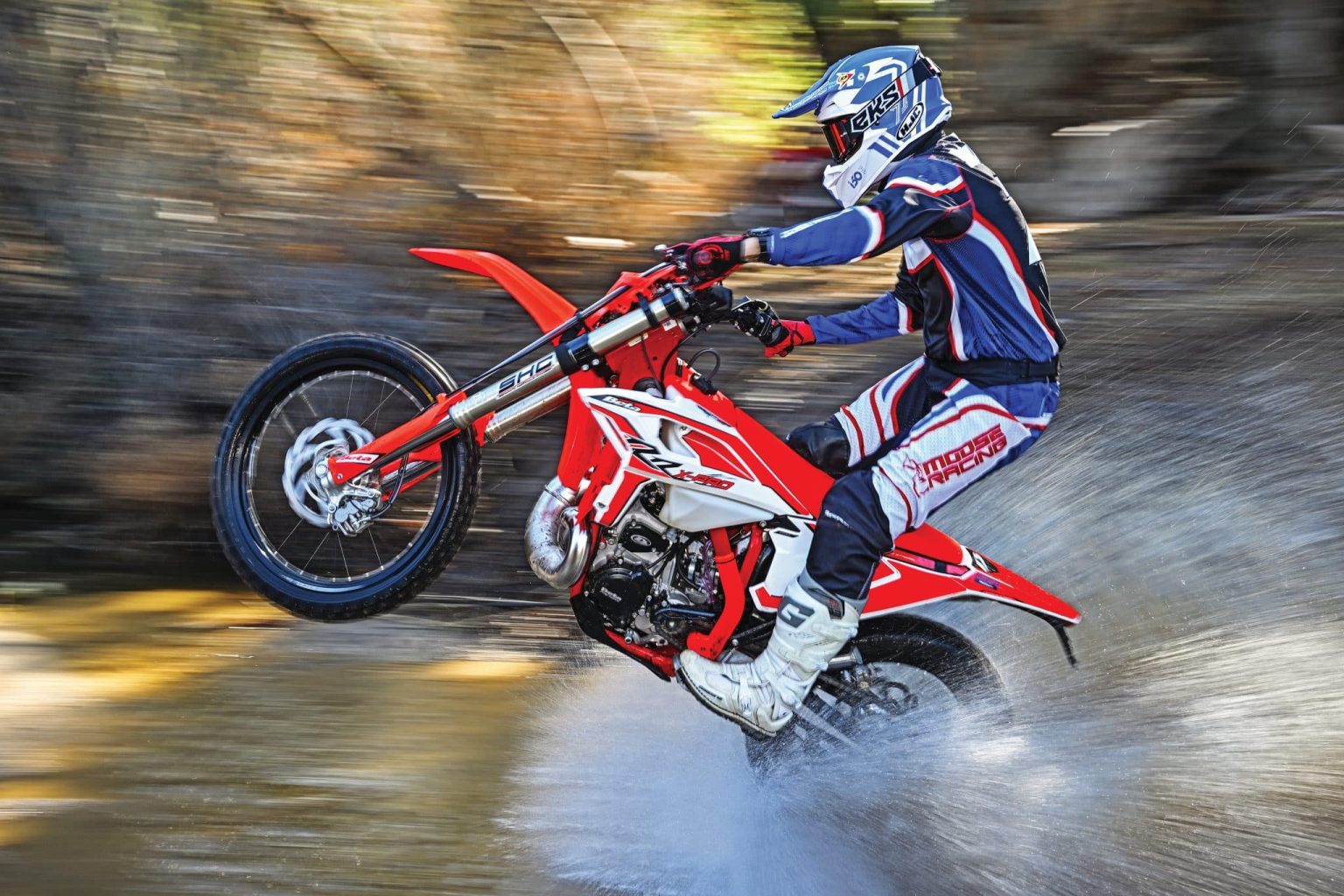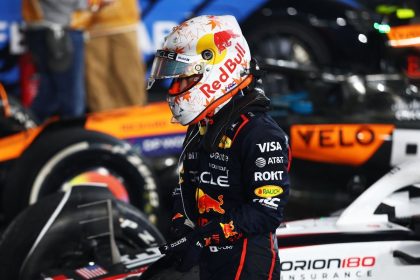THE BIKE THAT WILL SAVE THE TWO-STROKE: MAY 2025 ISSUE
The Beta 300RR X-Pro is marketed as a trail bike, but it clearly has some racing DNA.
Old school and proud of it – the Beta 300RR X-Pro is for the off-road purists
The Wizard of Oz told the citizens of the Emerald City that his journey into the stratosphere was “technically unexplainable.” Almost immediately, he lost control of his balloon and shouted, “I can’t come back! I don’t know how it works!”
Most modern off-road bikes are on the brink of becoming technically unexplainable and leaving us behind. The Beta 300RR X-Pro, on the other hand, is perfectly explainable and traditional. It’s a carbureted two-stroke with a mechanical power valve and a distinct lack of wizardry. It’s a bike meant to appeal to off-road purists who don’t want to contact a service center every time a check-engine light comes on.
At the same time, Beta isn’t sitting still. This is a bike with a long list of upgrades and changes for 2025. No matter how much respect we might have for old-school technology, no one really wants to ride a motorcycle from the last century.
The 2025 Beta 300RR X-Pro sells for $9899. For competition, Beta also sells the 300RR Race edition for $10,699.
MOVING FORWARD
The “X-Pro” moniker is new for 2025. Beta wanted to make sure everyone knew it wasn’t the same old thing, even if its description sounds old-fashioned. It’s still a case-reed engine with a Keihin PWK 36mm carburetor and Moto Tassinari reeds. The power-valve design uses a centrifugal ball-ramp actuator and limited mechanical adjustment. The suspension is manufactured by Sachs, and the frame is steel with a central backbone. This year the frame was redesigned with input from Beta’s motocross team. It has a larger backbone with less flex. It also has a lower seat height and a new single-spring Sachs ZF SHC fork. That fork is considerably lighter than the old one and contributes to an overall weight loss. On our scale, the 300RR X-Pro is 233 pounds without fuel. Beta has made steady progress in the weight department over the past few years, and now the 300RR X-Pro is within a pound or two of the current KTM 300XC-W.
The Beta’s power valve is still operated by a mechanical governor. A manual adjuster allows you to change how quickly it opens.
The other changes for 2025 include re-valving of the Sachs shock, a bigger Nissin rear brake caliper, XTrig elastomeric handlebar mounts, a coolant overflow reservoir and a rescue strap on the front fender. The bodywork is new this year as well, and a new color scheme gives the bike a very different appearance.
Some things haven’t changed. The Beta X-Pro models take the place of the standard RR trail bikes, so the two-strokes all have electronic oil injection. There’s an oil reservoir under the seat, which can be removed with a push of a button. There are two ignition maps available on the handlebar pad, which alter spark advance alone. If you want to adjust the power valve, you do it the old-fashion way by physically tuning a preload adjuster down on the power-valve governor.
Weight has been coming off Beta’s two-strokes, pound by pound, on a yearly basis. Now, the 300 is as light as anything in its class.
For 2025 we have a long list of changes that includes a new frame and bodywork.
CARB LOADING
The Beta 300’s power delivery is the stuff of dreams. It makes smooth, usable torque from the very, very bottom, where most four-strokes won’t even run. In the middle, it’s smooth and throaty, and on top, it’s respectable and clean. There’s no detonation, it doesn’t load up, and it never misses a beat. If carburetors had always worked this well, no one would have even thought to invent fuel injection. The stock jetting is spot-on, at least for our testing conditions. We rode it in temperatures ranging from 50 to 80 degrees and at altitudes between sea level and 4000 feet. It ran perfectly everywhere. In the old days, we never had two-strokes that worked so well in such a wide variety of conditions. What’s different? Part is probably because of evolutionary advancement in the Beta’s ignition system, which is made by Kokusan. The rest is simply good engine design. A long time ago, the Beta was criticized for being a copy of a KTM two-stroke to the point that it used many of the same top-end parts. That’s no longer valid. The 300RR X-Pro doesn’t even have the same bore and stroke as the KTM.
In outright power, the 300RR X-Pro is decent but not overwhelming. The map switch offers a choice between a sunshine emoji and a rain cloud, but when you switch back and forth, you only notice a change in peak revs. The power characteristic down low doesn’t change much. If you absolutely feel the need for fiddling, you can focus on the power-valve preload adjuster. Ours came set to a half-turn clockwise from flush with the case. You start noticing changes when you change the adjuster a full turn in either direction. Either way, it seems the motor only develops a harder hit; you just end up moving that hit around. We eventually returned to the original setting.
The Beta 300RR X-Pro is a carbureted two-stroke with a mechanical power valve and a distinct lack of wizardry. It’s mean to appeal to off-road purists who don’t want to contact a service center every time a check-engine light comes on.
TALES OF THE TRAIL
Benny Bloss is in his second year on Beta’s factory Supercross team. He’s 6-foot-6 and has no trouble touching the ground on any motorcycle made. Someone at Beta realized that most trail riders are not Benny Bloss. Between the new frame and new suspension components, the seat height has come down. Beta says it’s 20mm lower than last year’s model, and while that number might be a little overstated, there’s no question that the new bike is a touch lower than the average dirt bike. That helps boost anyone’s confidence in tight, slow trails. If Benny was a trail rider, we would bet that even he would appreciate it.
Some of that height difference came out of the suspension travel, but for trail riding, no one will notice and no one will care. This is a bike with deliberately soft, cushy suspension. It’s at its best in slow, technical terrain where rocks, roots and holes are the main issue. It’s well balanced and the action is good, but it’s not made for jumps, big whoops or high speeds. It will bottom and dive when you venture out of its designated comfort zone. For racing, Beta has a completely different line of Race editions. Those bikes have KYB suspension, a little more travel and, yes, more seat height. The two-stroke Race editions also ask you to mix your own oil and gas, and sell for more.
All of the components are of excellent quality, including the Maxxis tires and Nissin brakes.
A push-button release mechanism allows you to remove the seat and access the oil tank and battery.
BE WHO YOU ARE
There’s a very real pushback against bikes that are too sophisticated, too complicated and too specialized. The 300RR X-Pro is none of those things, but to call it a trail bike sounds dismissive, as if it’s made for kids who can’t handle a real bike. That’s the wrong picture. In truth, it’s a very high-performance off-road motorcycle and isn’t that far removed from the bike that Max Gerston rode in the 2024 EnduroCross Pro class. But, by having a separate line for racers, Beta had the freedom to make the 300RR X-Pro more comfortable, more convenient and more friendly. In truth, it’s the kind of bike that almost all racers would prefer to ride, whether they are racing or not.












